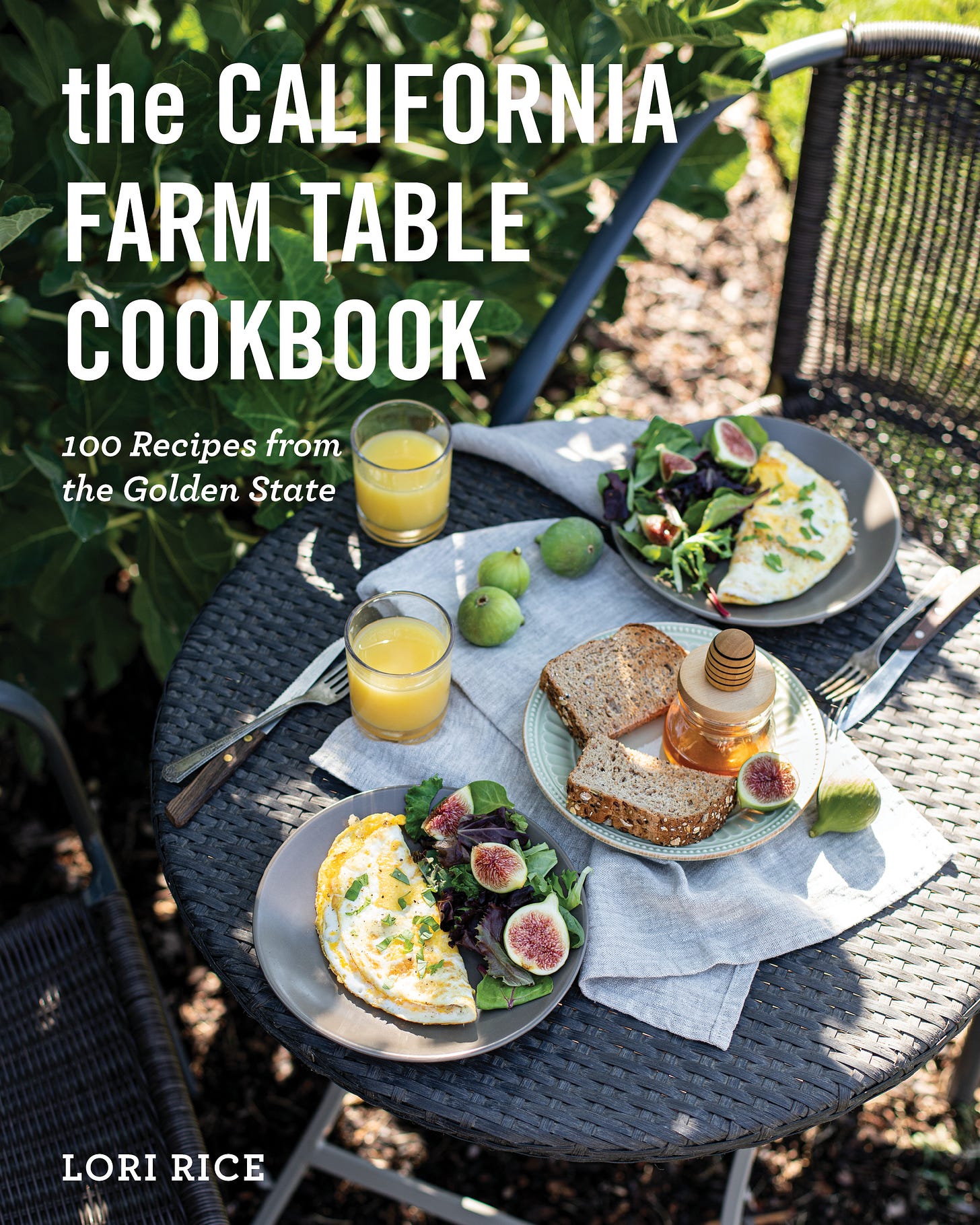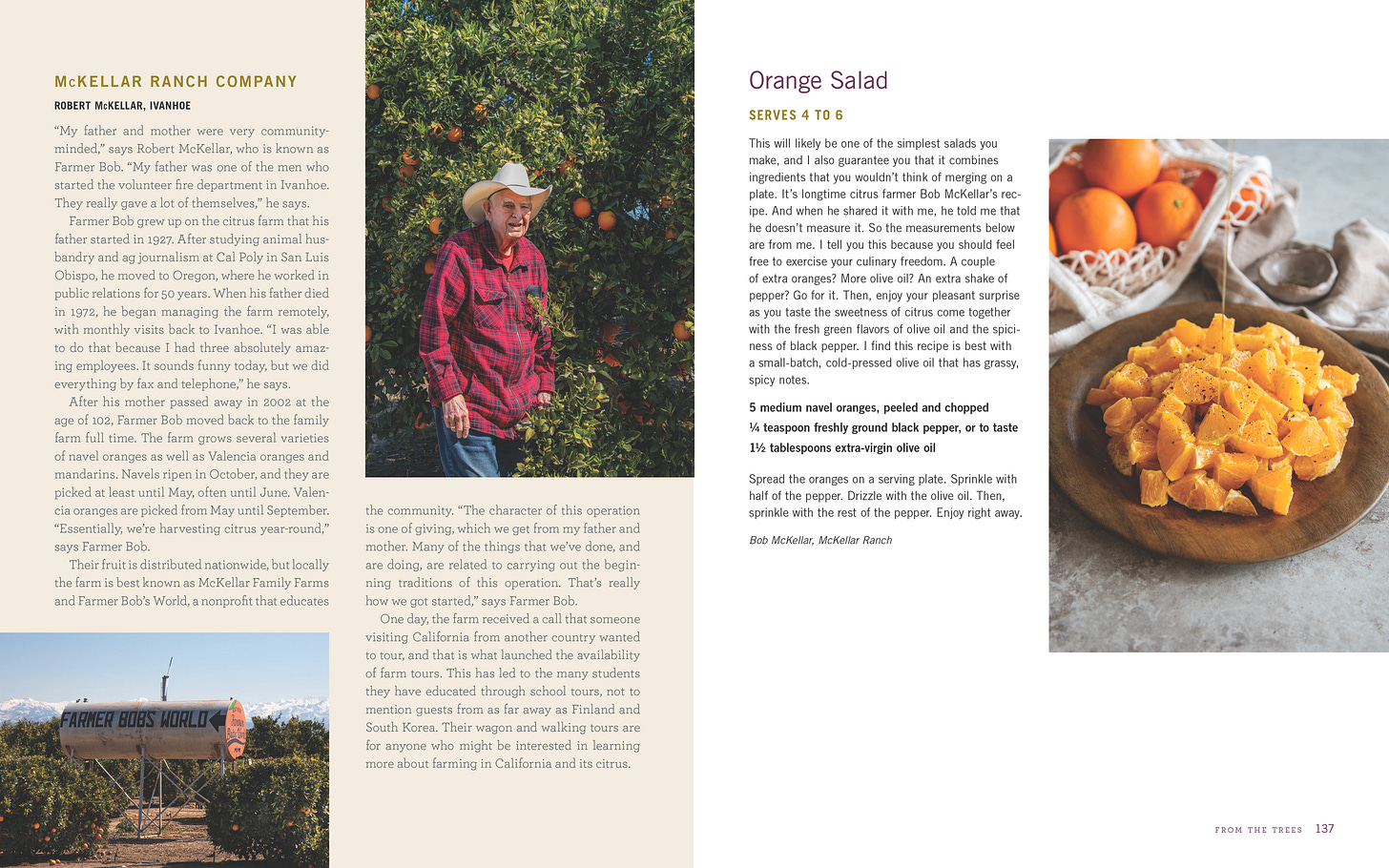The Writer Behind the California Farm Table Cookbook
An Interview with Lori Rice of Paso Robles
I almost shouted when I first saw The California Farm Table Cookbook on a table at Mrs. Dalloway’s, my favorite bookstore in Berkeley. I don’t know how this book wasn’t on my radar earlier—it’s a treasure trove of California stories and recipes, full of interviews with food producers like Brown Girl Farms and chefs like Rachel Ponce. As soon as I finished paging through it, I reached out to the author, Lori Rice, a food writer, photographer, and stylist. She was happy to share her story with me, and a bit about how this wonderful book came to life. She also shared her delicious recipes for Wild Rice with Broccolini, Dates, and Pecans, which I’ll share next week (it would make a great Thanksgiving side!) But first, here’s what Lori told me, via email:
How/when did you first come to CA? Where did you grow up and what brought you here?
My husband and I moved to the Bay Area 12 years ago. After 3 years of living in Oakland and Alameda, we moved to the Central Valley in Visalia for 5 years. We moved to San Simeon in 2021 after being part-timers on the coast since 2019 and then moved over to Paso Robles earlier this year.
I grew up in Indiana and we were was based for 10 years in Lexington, Kentucky with 3 years of that spent living abroad in Southern Brazil. We’d always loved the West Coast. My husband received a job offer not long after we moved back to Kentucky from Brazil. We decided it was time to explore California and we haven’t left.
What was the cooking like during your childhood? Who cooked and what style was it (ie, what kinds of food influences informed your early ideas about food)?
My mom cooked and baked nearly every meal. She owned and operated a birthday and wedding cake business out of our home for most of my childhood until I left for college. While all her cooking was delicious, it involved a lot of similar ingredients and processes – vegetables my dad grew, roasted meats, chicken and dumplings, the occasional lasagna and spaghetti. My paternal grandmother passed down outstanding recipes for desserts such pies, cakes, and cookies that my mom perfected. She cooked and baked many recipes that she also learned from my great grandmother that were rooted in German traditions. I learned a lot of the basics from growing up in that environment.
What was your cooking like before you moved to CA? How did you learn to cook/what were your primary influences/what kinds of foods did you make regularly at home?
Like many people around my age, what I learned about the varying processes of cooking and baking, best practices, and exploring more ingredients (fresh herbs versus dried, fresh garlic versus garlic powder) came from television. The Food Network and stars such as Rachael Ray, Ina Garten, and Alton Brown were on repeat in the background of my college years and early adulthood. I was simultaneously earning a BS in Family and Consumer Sciences—Nutrition, Fitness and Health which included a lot of food science. I worked in a bakery from high school until early college including early morning sweets prep and as one of our main bakers. Later I worked in a bagel shop doing dough prep and baking. All the interests began to come together.
Initially it all channeled into a love of nutrition and health education. While some people may have turned to culinary arts at this point, I went on to get my degree in Nutritional Sciences—Wellness and Sport Nutrition. I cooked a lot but used a lot of prepared ingredients (shredded cheese, canned beans). It wasn’t until I started traveling and the moved abroad that I started to see food and ingredients the way I do now—with so much curiosity, so much possibility, and as an open book of our histories.
When you first started cooking in CA, what did you notice about how being here was affecting what you were eating or cooking? What changed in how you approached food or surprised you about cooking here?
My answer probably isn’t what you expect to hear—it didn’t change. Before coming here, I spent 10 years in Central Kentucky and was part of a community that was advocating for farm-to-table and eating seasonally. I purchased our meats by visiting local farms and butchers sourcing from them; those that were implementing practices from celebrated people in the industry such as Temple Grandin. I grew food, shopped the farmers market, dined at restaurants where chefs did the same. Central Kentucky is every bit like California when it comes to high quality local food and celebrating those who make and grow it.
What California exposed me to was the vastness of our food system, family farms that have been operating for generations, diversity in the origin of our foods, and some ingredients that I could now proudly call local that I had never experienced before – local citrus, pomegranates, dates, figs, rice – along with year-round farmers markets. I also got exposed to local foods from the sea which was brand new to me. The multiple regions, climates, and growing seasons was fascinating as well. My work here has exposed me too so much. At this point there may only be a few ingredients grown in the state that haven’t had first-hand experience with or seen grown and processed in person.
How did the idea for this book come about, and how did you decide which farmers to feature?
The Farm Table books are a series that Countryman Press has done in a few different states. Back in 2018, between the publication of my books Food On Tap and Beer Bread, my publisher asked me to write the California book. We couldn’t really agree what to include, considering there was so much, and I ultimately decided it wasn’t the time. I’d only lived here for about 5 years and only in two places. I didn’t feel like I had enough resources to do it justice.
On a road trip across the country in 2022, I stumbled on the Vermont book at a cider mill gift shop and it prompted me to ask my publisher if they'd produced the California book yet. They had not and asked me to write it again. I felt it was time.
I started first with the chapters to outline the types of foods I wanted to cover. Then I considered all the producers I knew personally and slotted them and what they produced in the chapters. That left me with gaps, both gaps in food represented and regions of the state. From there I worked on contacts, referrals, and my own research to fill those gaps, and to make sure that the book was inclusive, accurately representing the diversity of those who provide us with food and drink in this state.
I could easily write a volume 2 at any time. It was hard to limit myself to the page number I was restricted to.
How were the recipes in the book developed?
About 10 or so recipes are from [the people] featured in the book. I was thrilled to have chefs and mixologists contribute and farmers trust me with long-time family recipes. I was hoping the book would have more contributors, but it proved a difficult thing to navigate. Not as many producers had something to share. So the rest of the recipes are developed by me—many created through a collision of my past with my current life. Meaning ideas and favorites from my childhood, living in Kentucky, travel, living abroad, and giving them new life through California’s incredible ingredients. Others were inspired by my farm visits.
What recipes should people start with if they're picking up your book for the first time?
I speak to this in the chapter intro, but I’m partial to the From the Trees chapter. It’s because it represents the foods that were the most thrilling to me to have access to being a transplant. So many varieties of citrus, pomegranates, figs, persimmons, avocados, nectarines, dates. Wild Rice with Broccolini, Dates, and Pecans, the Pistachio Flatbread with Red Grapes, and the Skillet, Nectarine and Sweet Corn Salad represent the kind of simple foods celebrating California ingredients that I make all the time.


Did you learn anything in the process of working on this book that surprised you?
It wasn’t so much something that surprised me as it was something I was reminded of. Everything around us seems so strongly divided these days and it’s something that has really been present for years if you are into local food. Big farms versus small farms, craft production versus large scale, everyone has a side. Visiting the farms and with the people represented in this book reminded me how interconnected we are. How, despite varying view points and beliefs, we are all very similar in our mission and what we value. We are all an important part of a bigger picture.
On a personal level, I wasn’t expecting so much of my past experiences with food to show up in this book. It inspired a lot more than I was prepared for it to. But in the end the book really brings things full-circle for me and my work.
More California Food Stories
Here are a few of the things I’ve been reading when I need a break from doom scrolling and election panic: The SF Chronicle has a lovely story about bringing chinook salmon back to the North Yuba River, and the Sacramento Bee published a story about the olive harvests at Seka Hills (my go-to olive oil whenever possible), Bondolio, and other Northern California olive oil producers. KQED has a piece about El Garage planning pop-ups across the East Bay (fantastic news for anyone missing their crazy good quesabirria), and LA Taco recently ran a story about Mexicali-style burritos sold by El Cachanilla Burritos, a street vendor that sets up shop on Vermont Avenue in Los Angeles.
Photos: Lori Rice; spreads courtesy of W. W. Norton & Company









AS you did for your book, I loved writing The California Farm cookbook in the mid 1908s (Pelican Publishing). It was wonderful to visit growers around the state and get their own recipes for their products. Still one of my favorite subjects to write about! California farmers are the best.